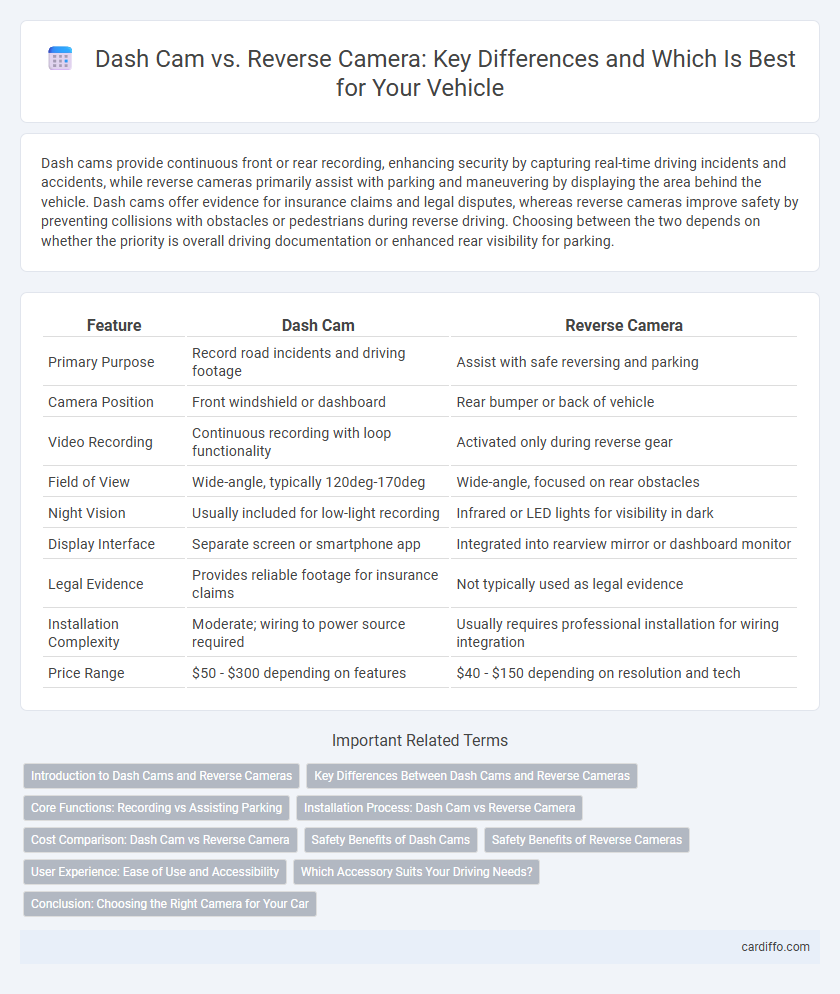Dash cams provide continuous front or rear recording, enhancing security by capturing real-time driving incidents and accidents, while reverse cameras primarily assist with parking and maneuvering by displaying the area behind the vehicle. Dash cams offer evidence for insurance claims and legal disputes, whereas reverse cameras improve safety by preventing collisions with obstacles or pedestrians during reverse driving. Choosing between the two depends on whether the priority is overall driving documentation or enhanced rear visibility for parking.
Table of Comparison
| Feature | Dash Cam | Reverse Camera |
|---|---|---|
| Primary Purpose | Record road incidents and driving footage | Assist with safe reversing and parking |
| Camera Position | Front windshield or dashboard | Rear bumper or back of vehicle |
| Video Recording | Continuous recording with loop functionality | Activated only during reverse gear |
| Field of View | Wide-angle, typically 120deg-170deg | Wide-angle, focused on rear obstacles |
| Night Vision | Usually included for low-light recording | Infrared or LED lights for visibility in dark |
| Display Interface | Separate screen or smartphone app | Integrated into rearview mirror or dashboard monitor |
| Legal Evidence | Provides reliable footage for insurance claims | Not typically used as legal evidence |
| Installation Complexity | Moderate; wiring to power source required | Usually requires professional installation for wiring integration |
| Price Range | $50 - $300 depending on features | $40 - $150 depending on resolution and tech |
Introduction to Dash Cams and Reverse Cameras
Dash cams record real-time video footage of driving, enhancing road safety by capturing incidents and providing evidence in case of accidents. Reverse cameras assist drivers in parking and reversing by offering a clear view of the area behind the vehicle, reducing blind spots and preventing collisions. Both accessories improve driving awareness but serve distinct purposes: dash cams focus on forward monitoring while reverse cameras enhance rear visibility.
Key Differences Between Dash Cams and Reverse Cameras
Dash cams primarily record the road ahead to capture driving incidents, providing continuous video footage for security and evidence purposes. Reverse cameras are specifically designed to assist with parking and reversing by displaying a live rear-view image on the dashboard screen, enhancing safety and preventing collisions. The key difference lies in their functionality: dash cams focus on forward surveillance and recording, while reverse cameras emphasize real-time rear visibility and maneuvering assistance.
Core Functions: Recording vs Assisting Parking
A dash cam primarily focuses on recording continuous video footage of the road ahead to capture incidents and provide evidence during accidents. In contrast, a reverse camera is designed to assist parking by offering real-time visual guidance and enhancing rear visibility to prevent collisions. While dash cams function as passive recorders, reverse cameras actively support maneuvering in tight spaces.
Installation Process: Dash Cam vs Reverse Camera
Dash cams typically require mounting on the windshield or dashboard with power connections routed to the vehicle's fuse box or cigarette lighter, often involving discreet wiring for continuous recording. Reverse cameras demand precise positioning on the rear bumper or license plate area, with installation requiring routing video cables through the vehicle body to the dashboard monitor and connecting to the reverse light circuit for automatic activation. The reverse camera installation is generally more complex and time-consuming compared to the straightforward setup of a dash cam.
Cost Comparison: Dash Cam vs Reverse Camera
Dash cams typically range from $50 to $200, offering front and sometimes rear recording capabilities with added security features. Reverse cameras are generally priced between $20 and $150, primarily serving as a parking aid with real-time video feed for safer maneuvering. While dash cams provide broader functionality, reverse cameras tend to be more budget-friendly and specialized.
Safety Benefits of Dash Cams
Dash cams provide continuous recording of the road, offering critical evidence in case of accidents or disputes, which enhances driver safety and accountability. Unlike reverse cameras that assist only during parking and low-speed maneuvers, dash cams monitor the entire journey, capturing real-time incidents and potentially deterring reckless behavior. Their wide-angle lenses and night vision capabilities improve overall situational awareness, making them invaluable for accident prevention and traffic law enforcement.
Safety Benefits of Reverse Cameras
Reverse cameras significantly enhance vehicle safety by providing a clear view of blind spots behind the car, reducing the risk of accidents during parking and reversing maneuvers. They help detect obstacles, pedestrians, and other vehicles that may be difficult to see using mirrors alone. This added visibility improves driver awareness and minimizes the likelihood of collisions, particularly in tight or crowded spaces.
User Experience: Ease of Use and Accessibility
Dash cams offer continuous front or rear recording with straightforward operation through one-touch controls and automatic activation, enhancing user convenience while driving. Reverse cameras provide real-time video feedback directly on the dashboard display during parking, significantly improving maneuverability with intuitive visual guides. Both devices are designed for seamless integration and accessibility, but reverse cameras prioritize immediate spatial awareness in tight situations, whereas dash cams emphasize ongoing safety monitoring.
Which Accessory Suits Your Driving Needs?
Dash cams provide continuous front and rear video recording, ideal for capturing incidents and enhancing road safety during regular driving. Reverse cameras offer real-time visual assistance when parking or reversing, reducing blind spots and preventing minor collisions. Choosing between a dash cam and a reverse camera depends on whether you prioritize overall journey documentation or enhanced maneuvering support in tight spaces.
Conclusion: Choosing the Right Camera for Your Car
Dash cams provide continuous front and rear recording, offering comprehensive evidence in case of accidents and security incidents, making them ideal for drivers seeking all-around surveillance. Reverse cameras enhance safety during parking and reversing by offering clear rear views, reducing blind spots and preventing collisions with obstacles or pedestrians. Selecting the right camera depends on your primary need: opt for a dash cam for overall road monitoring or a reverse camera to improve maneuvering and parking safety.
Dash cam vs Reverse camera Infographic

 cardiffo.com
cardiffo.com